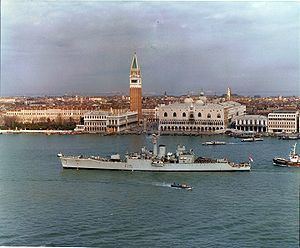Name HMS Berwick (F115) Laid down 16 June 1958 Construction started 16 June 1958 Length 113 m Displacement 2.49 million kg | Completed 1 June 1961 Launched 15 December 1959 Weight 2,490 tons Builder Harland and Wolff | |
 | ||
HMS Berwick was a Rothesay or Type 12I class anti-submarine frigate of the British Royal Navy. She was built by Harland & Wolff and launched on 15 December 1959.
Contents
Operational Service
Between 1963 and 1965 Berwick was leader of the 21st Escort Squadron. During the Beira Patrol, she stopped and arrested SS Manuella for attempting to run the oil blockade of Rhodesia (now Zimbabwe) on Easter 1966. Berwick was re-fitted with helicopter landing facilities in 1967.
From July 1975 to April 1976, she went around the world via the Suez and Panama canals. Other ships in the flotilla included Ajax, Plymouth, Llandaff, Rothesay and Glamorgan. Destinations included Gibraltar, Malta, Egypt (Port Said), India (Madras), Singapore, Hong Kong, Australia (Fremantle, Hobart and Sydney), New Zealand (Nelson and Timaru), Fiji, Samoa, Hawaii, California (San Diego and Long Beach), Panama and finally Curaçao.
In 1977, she attended the Silver Jubilee Fleet Review with sisterships Plymouth and Rothesay. At this time she was part of the 8th Frigate Squadron. Manpower shortages saw HMS Berwick transferred to the standby squadron in 1979 and conversion of the frigate to operate a towed array was scheduled, but didn't take place due to the Nott defence cuts and industrial action. Nevertheless the Falklands War saw Berwick reactivated in a couple of months, to conduct two successful post war tours with the South Atlantic task forces, in 1982-83. Her final years saw her active on West Indian training cruises, and she was paid off in 1985.
Berwick was sunk as a target ship on 18 August 1986 by a Tigerfish torpedo, which was fired from the submarine Tireless.
